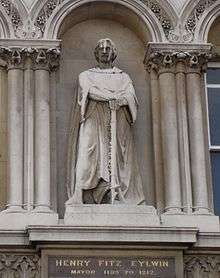Henry fitz Ailwin
| Henry fitz Ailwin de Londonstane | |
|---|---|
 | |
| 1st Lord Mayor of London | |
|
In office 1189–1212 | |
| Preceded by | New title |
| Succeeded by | Roger fitz Alan |
| Personal details | |
| Born | ca. 1135 |
| Died | 19 September 1212 |
| Nationality | English |
| Children |
Peter fitz Henry Alan fitz Henry Thomas fitz Henry Richard fitz Henry |
| Occupation | businessman and landowner |
Henry fitz Ailwin de Londonstane (c.1135– 19 September 1212) was an English businessman and landowner who served as the first Mayor of the City of London (the title becoming Lord Mayor of London from 1347 and then Lord Mayor of the City of London from 2006).[1] In office from about 1189 until his death in 1212, he was the only mayor to hold the post for life.[2]
Origins
Of English rather than Norman descent, fitz Ailwin's family had been active in the commercial and civic life of London for generations. His grandfather Leofstan (died about 1115) was probably the portreeve of London, who in 1108 was involved in the foundation of Holy Trinity Priory, Aldgate. The house of his father Ailwin (died 1164/5) was where the husting court of London met and his uncle Robert was an official of the weavers' guild in 1130.[2]
Career
Little is known of his business interests, which probably centred on making, finishing, and selling cloth. In politics, he was an alderman by 1168 and became one of the most influential men in the city.[2] Under King Richard I and his brother King John, the royal need to raise finance from London businessmen resulted in the grant of greater autonomy to the city, which previously had been governed by a portreeve, an officer of the crown.[3] Instead, the office of mayor emerged, with fitz Ailwin first named as such in 1194.
In 1193 he was one of the those entrusted with the money collected for the King's ransom and in 1208 negotiated for the use of ground outside the walls as a city burial ground.[2] After the great fire of 1212, he and other city officials issued a code governing new building that expressly emphasised fire prevention and safety.[4] FitzAilwin promulgated the law known as the Assize of Building forms the basis of the modern law of trespass. The Lex de Assisa authorised ten men, who became known as alder men.[5] Since the devastating fire of Stephen's reign had gutted all London, FitzAilwin was decided that some efforts should be made to bring in Regulations to build houses in stone. The Assize of Nuisance was described by Bracton in his Notes as being applicable to property freeholders, so the damage had to be seen to be believed.[6] According to Glanvill the case was a variant of the novel disseisin, upon which the owner could sue for the damage caused.[7] As parliament's powers grew it developed into twelve men chosen at full Hustings, originally held in FitzAilwin's house, that laid the foundations of the jury system at assizes.[8]
He gave generously to church causes, with endowments to Holy Trinity Priory, St Bartholomew's Hospital, Westminster Abbey, the Chapel of St Thomas on the Bridge completed in 1209, and to the nunneries of St Mary, Clerkenwell and Godstow. He contributed to the foundation of St Mary Spital and at Watton-at-Stone was remembered as the founder of a chapel. He died on 19 September 1212 and was buried in Holy Trinity Priory, where his tomb could still be seen in the sixteenth century. There was also a memorial to him in the church of St Mary Bothaw.[2]
Landholdings
In 1165 he and his brother Alan inherited their father's lands, probably those at Watton-at-Stone in Hertfordshire, [9] which became his country home. He also had properties at Edmonton in Middlesex, in Surrey, and beside the Thames in Kent. In London, his business headquarters were on what was then called Candlewick Street, now Cannon Street, and he also owned many premises in the eastern half of the city.[2]
Family
His widow was named Margaret and was probably the mother of his four sons: Peter, Alan, Thomas and Richard. Peter, the eldest, married Isabel, daughter of Bartholomew de Chesney, of Addington, Surrey, and died in 1211 before his father. His heiress was his daughter Joan, who also inherited the assets of her three uncles. She married William IV Aguillon and in 1235 was the mother of Sir Robert II Aguillon.[2]
References
- ↑ "History of the Mayoralty". City of London.
- 1 2 3 4 5 6 7 Derek Keene, ‘Henry fitz Ailwin (d. 1212)’, Oxford Dictionary of National Biography, Oxford University Press, 2004; online edn, Jan 2008
- ↑ Charles Knight, The Popular History of England (1856) Bradbury and Evans
- ↑ "London Nuisance, 1301-1431: A Calendar". London: London Record Society. 1973. Retrieved 2018-05-11.
- ↑ Chronicles of the mayors and sheriffs of London translated by H.T. Riley (1863); 'Liber Albus', ed. H.T.Riley, Munimenta Gildhallae Londoniensis, i, (1859), pp.319-32
- ↑ Bracton, De legibus et consuetudinibus Angliae, ed. G. E. Woodbine, iii (1940), 189–99. Cf. Fleta, iii (Selden Soc., lxxxix, 1972), 110–18.
- ↑ Glanvill, Tractatus de legibus, ed. G. D. G. Hall (1965), 34–6.
- ↑ Liber Albus., i, 321–1
- ↑ "History of Watton-atte-Stone". Retrieved 2018-05-11.
External links
| Civic offices | ||
|---|---|---|
| Preceded by New title |
Lord Mayor of the City of London 1189–1212 |
Succeeded by Roger fitz Alan |